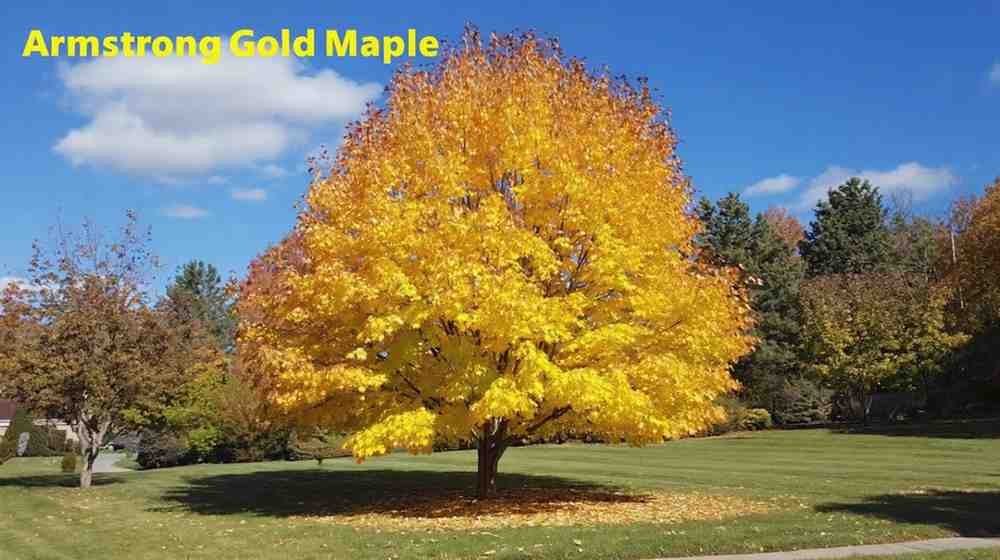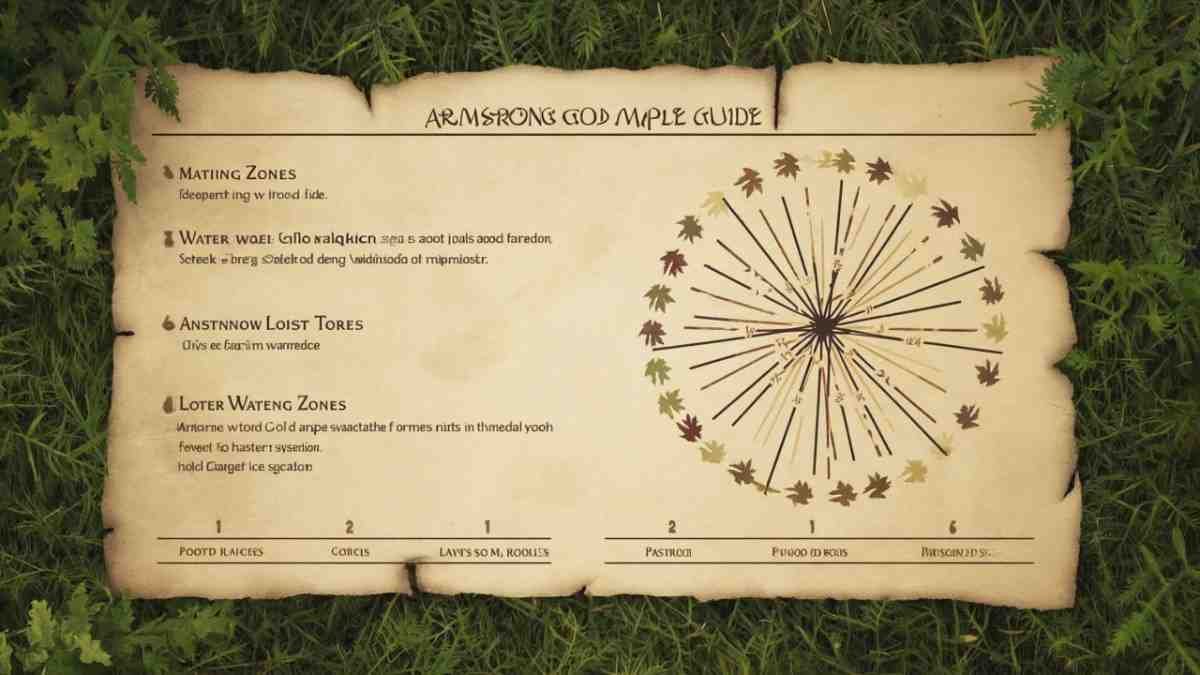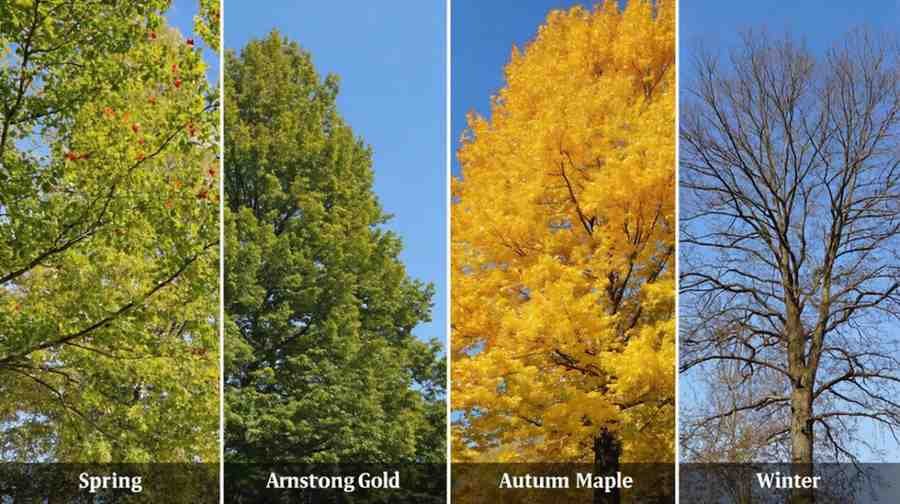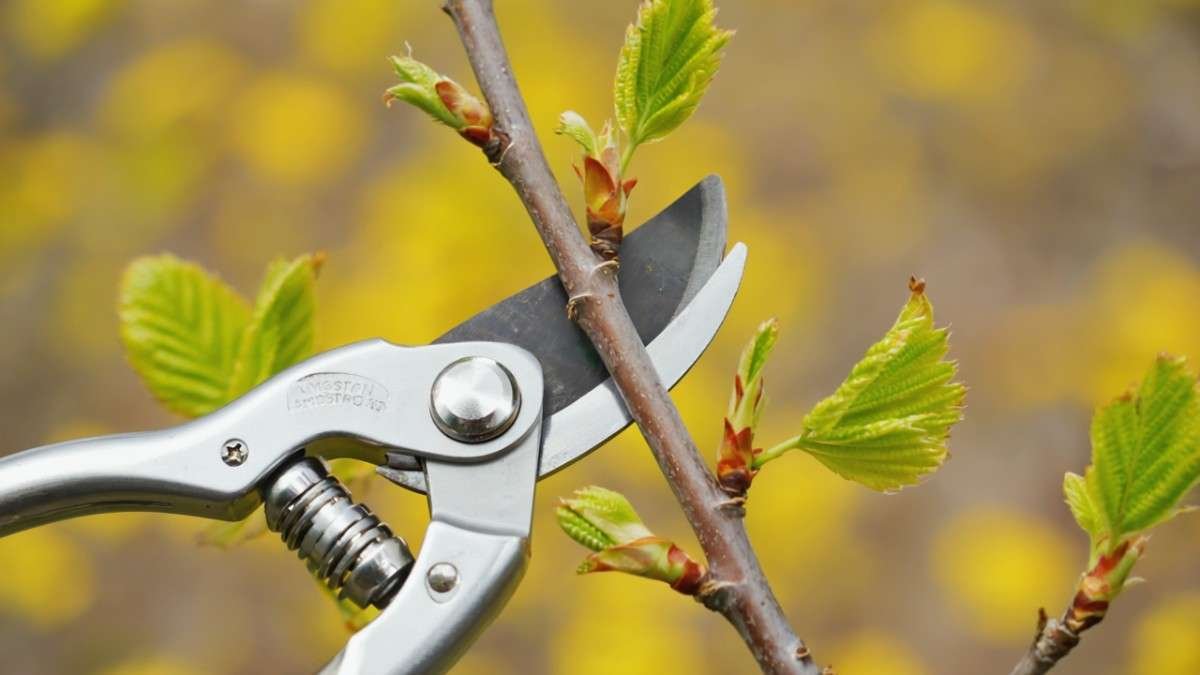Five years ago, I planted my first Armstrong Gold Maple Tree in my backyard. Honestly, I had no idea it would become my favorite garden companion. I still remember standing there, shovel in hand, doubting if I could even keep it alive. Fast forward, and now it’s the pride of my yard. Tall, elegant, and glowing golden in autumn — it’s a showstopper. This tree taught me patience, persistence, and the joy of watching something flourish over time. And believe me, caring for an Armstrong Gold Maple Tree is as rewarding as it sounds.
Table of Contents
ToggleWhat Makes the Armstrong Gold Maple Tree Special

The Armstrong Gold Maple Tree isn’t just another tree you plant and forget. It’s a living work of art. Known for its tall, columnar growth, it’s perfect for narrow spaces. The leaves? They start fresh green in spring, then turn rich golden-yellow in fall. And the best part — it grows fast. If you’ve got an impatient gardener’s heart like mine, that’s music to your ears. Plus, it’s hardy in a variety of climates, making it a favorite for gardeners worldwide. Whether in a cozy backyard or lining a grand driveway, it shines.
Appearance and Growth Habits

Picture this: a sleek trunk, neatly stacked branches, and leaves shimmering like gold coins in the sunlight. The Armstrong Gold Maple Tree grows about 40–50 feet tall, but its narrow width (just 12–15 feet) makes it perfect for tight urban spaces. It’s a hybrid of beauty and practicality. It thrives in USDA zones 4–9, handling both chilly winters and warm summers. And yes — it grows fast. We’re talking about 2–3 feet per year if it’s happy. It’s the kind of tree that says, “Stand back, I’ve got places to be.”
Planting the Armstrong Gold Maple Tree

When planting, location is everything. Choose a spot with full sun to partial shade. Dig a hole twice as wide as the root ball, but no deeper than its height. Why? Roots hate being buried too deep. Trust me, I made that mistake once and the tree sulked for months. Backfill with loose, nutrient-rich soil, water generously, and mulch to retain moisture. Oh, and skip fertilizing at planting time. Let it settle in first. Think of it like moving to a new home — you need time before rearranging furniture.
Soil and Water Requirements

This tree isn’t overly fussy, but it does have preferences. Well-drained soil is a must. If your soil tends to be clay-heavy, amend it with compost. Water deeply once a week during the first couple of years, especially in dry spells. I once skipped watering during a particularly hot summer week, and the leaves curled up like taco shells. Lesson learned. A good soak beats a quick sprinkle any day. Once established, the Armstrong Gold Maple Tree is fairly drought-tolerant — but don’t push your luck.
Seasonal Beauty

Spring brings fresh, bright green leaves that almost hum with energy. Summer keeps that lush green going, making it a soothing backdrop for your yard. Then autumn arrives, and this tree earns its name — turning gold like the last rays of a sunset. I’ve had neighbors stop mid-walk just to admire it. Even winter has its charm, with the tree’s clean structure and upright form adding elegance to a bare garden. If you love year-round appeal, the Armstrong Gold Maple Tree delivers in style.
Advantages of Growing an Armstrong Gold Maple Tree

-
Fast Growth – Perfect for impatient gardeners.
-
Narrow Form – Ideal for small yards or tight spaces.
-
Low Maintenance – Minimal pruning needed.
-
Seasonal Interest – Gorgeous in every season.
-
Climate Flexibility – Thrives in zones 4–9.
-
Pest Resistance – Not a bug magnet.
-
Pollution Tolerance – Great for urban areas.
It’s like the Swiss Army knife of ornamental trees — useful, adaptable, and good-looking.
Common Problems (and How to Fix Them)

Even a hardy tree like the Armstrong Gold Maple Tree can run into trouble.
-
Leaf Scorch – Caused by heat or drought. Solution: Deep watering and mulch.
-
Chlorosis – Yellowing leaves from nutrient deficiency. Solution: Soil test and appropriate fertilizer.
-
Aphids – Rare, but annoying. Solution: Blast with water or use neem oil.
The key is catching issues early. Walk around your tree every now and then — it’s like a friendly check-up.
Pruning the Armstrong Gold Maple Tree

Pruning this beauty isn’t a complicated art. In fact, less is more. You only need to remove dead, damaged, or crossing branches. The Armstrong Gold Maple Tree naturally maintains its elegant shape. Late winter or early spring is the ideal pruning time. I’ve learned to avoid heavy summer cuts — they stress the tree. Use sharp tools, make clean cuts, and never remove more than a third of the canopy. Pruning isn’t just about looks. It’s about health. A well-pruned Armstrong Gold Maple Tree rewards you with strong growth and fewer disease problems.
Best Time to Plant

Timing matters. Plant your Armstrong Gold Maple Tree in early spring or early fall. Spring planting gives the roots a whole growing season to settle before winter. Fall planting, on the other hand, lets the roots establish without the stress of summer heat. I planted mine in late September, and it took off the next spring like it had been there for years. Avoid mid-summer planting — the heat can be brutal on young trees. Think of it as giving your maple the best possible start in life.
Fertilizing for Maximum Growth
While the Armstrong Gold Maple Tree isn’t a fertilizer hog, a little nutrition goes a long way. I feed mine every spring with a balanced, slow-release tree fertilizer. The trick? Don’t overdo it. Too much nitrogen can cause lush leaves but weak branches. Always follow the instructions on the package. And never fertilize late in the season — you don’t want new growth to get hit by frost. Healthy feeding keeps your tree vigorous, more resistant to pests, and glowing with seasonal color.
Landscaping Ideas

This tree is a landscaper’s dream. The Armstrong Gold Maple Tree works perfectly as a privacy screen, driveway border, or even a focal point in a small yard. I’ve seen them planted in rows for a dramatic avenue effect — breathtaking in autumn. Pair it with low-growing shrubs or perennials to highlight its slim form. In urban gardens, it’s perfect for tight spots without overwhelming the space. If you’ve got a deck or patio, planting one nearby means you get that golden fall glow up close.
Growing Armstrong Gold Maple Tree Worldwide
One of the reasons I recommend the Armstrong Gold Maple Tree so often is its adaptability. From chilly Canadian towns to sunny Australian suburbs, this tree thrives. It handles heat, tolerates cold, and shakes off urban pollution. Of course, it won’t love the tropics — but anywhere with defined seasons, it’s a winner. Just tweak your care routine. In hot, dry climates, water more often. In colder regions, mulch thickly in winter. No matter where you live, this tree can be part of your garden story.
Pests and Diseases
The Armstrong Gold Maple Tree is blessed with natural resilience. But that doesn’t mean it’s invincible. Aphids, scale, and leafhoppers might show up occasionally. A good spray from the hose or neem oil usually does the trick. Fungal leaf spots? Improve air circulation by thinning branches. Root rot? Avoid waterlogging at all costs. The secret is consistent observation. I’ve caught tiny problems before they became big headaches simply by walking past my tree with my morning coffee.
Winter Care

In colder climates, young Armstrong Gold Maple Trees appreciate a little winter TLC. Mulch heavily around the base to protect roots from freezing. If your winters are harsh, wrap the trunk with tree wrap to prevent frost cracks. Once mature, it’s tough enough to handle the cold. Mine has survived icy winds and heavy snow without complaint. Winter is also when you truly appreciate its architecture — those upright branches look striking against a snowy background.
Environmental Benefits
Beyond beauty, the Armstrong Gold Maple Tree works hard for the planet. It absorbs carbon dioxide, provides shade, and offers habitat for birds. Its narrow shape means it can be planted in more places, increasing urban greenery without taking up valuable space. I’ve noticed songbirds using mine as a rest stop, especially in spring migration. Every tree you plant is a step toward a greener future — and this one pulls its weight.
Advice for Success
-
Pick the right spot with plenty of sunlight.
-
Water deeply, especially in the first 2 years.
-
Mulch to conserve moisture.
-
Prune lightly for shape and health.
-
Fertilize in spring, sparingly.
-
Watch for pests early.
-
Enjoy its beauty — every single season.
The Armstrong Gold Maple Tree isn’t just a plant. It’s an investment in years of shade, color, and pride.
FAQs about Armstrong Gold Maple Tree
Q: How fast does the Armstrong Gold Maple Tree grow?
A: Around 2–3 feet per year under ideal conditions.
Q: Can it be grown in pots?
A: Not recommended long-term — it needs room for its roots.
Q: Is it messy?
A: Not at all. Minimal leaf drop except in fall.
Q: Does it attract pests?
A: Rarely, and they’re easy to control.
Q: What’s its lifespan?
A: With proper care, 60+ years.
Final Thoughts
Planting an Armstrong Gold Maple Tree isn’t just about adding greenery. It’s about adding life, character, and a changing piece of art to your home. Five years after planting mine, I still find myself stopping to admire it — in sunlight, in rain, even in the quiet of a snowy morning. It has become part of my story, and it can be part of yours. If you want a tree that grows with you, changes with the seasons, and stands tall through it all — this is the one.
When to Prune Maple Trees – A Gardener’s Guide with Grit, Guts
Celebration Maple Tree: The Backyard Hero with Fiery Swagger
Related Posts Links :
https://homegardeni.com/falling-for-maple-tree-species-a-leaf-a-story-a-whole-backyard/
https://homegardeni.com/celebration-maple-tree-the-backyard-hero-with-fiery-swagger/
https://homegardeni.com/maple-tree-identification-a-complete-and-fun-guide/
https://homegardeni.com/hot-wings-maple-tree-natures-spicy-twist-on-garden-beauty/
https://homegardeni.com/when-to-prune-maple-trees-a-gardeners-guide/